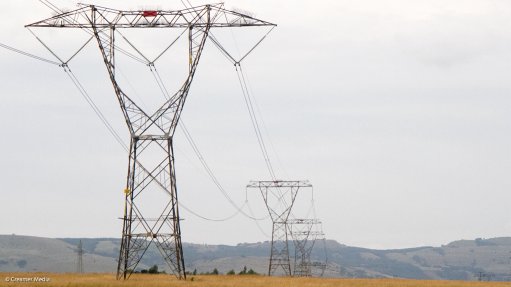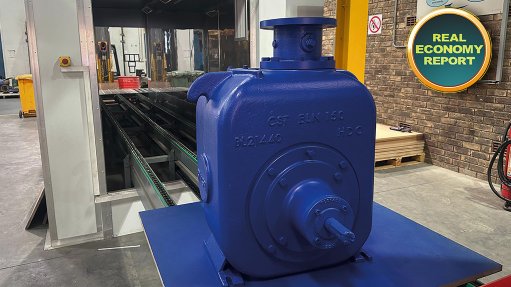Abrasives used in robotic applications
The use of robotics in manufacturing continues to grow at a rapid rate as businesses invest in automation to remain competitive.
PFERD South Africa national sales manager Dennis Phillips reveals that when implementing robotic applications in manufacturing, it is crucial to pair this high-performance equipment with equally high-performing consumables, if the aim is to optimise processes, reduce costs and improve overall operational efficiency.
He stresses that one of the biggest mistakes businesses make is that they combine a high-performing robot asset with substandard consumables, making it harder for the asset to reach its full potential and deliver repeatable efficiencies.
One of the benefits of robotic and automated processes is consistency, where surface finishes, for example, are reproducible by programming the robot with the same parameters repeatedly.
Phillips explains that, when a substandard abrasive is incorporated, the robot will be incapable of producing this consistency.
“This is because substandard or low-cost consumables don’t go through the stringent manufacturing processes and quality controls as, for instance, PFERD’s abrasives do,” he says.
Every production manager’s worst nightmare is unscheduled downtime, which is why robots must be relatively easy to operate, repair and maintain.
One of the consequences of incorporating substandard or incorrect consumables is decreased productivity.
“If the robot is paired with the incorrect consumables, downtime will increase, owing to the low or reduced service life of standard products resulting in regular stoppages to change out the used consumables. This can massively impact on the equipment’s output,” says Phillips.
Why the Move?
A shortage of skilled labour and a shift towards low-margin, high-volume models are fuelling this need to automate.
However, while more and more manufacturers are investing in robotic applications, many are not realising the full benefits of the technology, including increased productivity, improved quality, better efficiencies, and cost savings, because they are failing to pair the technology with equally high-performing consumables.
According to the latest ‘World Robotics Report’, released in October 2022, the top five industries for robotic adoption include electronics, automotive, metal and machinery, plastics and chemicals, as well as the food industry.
Technological advancements and the proliferation of robot technologies mean that robots are more cost-effective and easier to use than ever before.
Given their ability to work alongside humans and perform complementary tasks, collaborative robots, referred to as co-bots, have ensured that robotic technology is within reach even for smaller businesses.
The advantage of robotic applications is that they improve the overall efficiency and effectiveness of the manufacturing process by reducing manual work and delivering consistent results in shorter cycles.
Phillips points out that, when choosing a robot, the most suitable is the one that can achieve productivity gains and meet the technical requirements of the application.
“Other considerations are safety, space, upfront investment and after-sales support,” he adds.
The types of processes that are suitable for automation in the industrial sector are repetitive tasks that require precise movements and consistent accuracy, as well as tasks that are too dangerous or strenuous for humans to complete.
Selecting the most appropriate robot for an industrial application requires weighing up different attributes and criteria.
Typically, the selection criteria will be based on application, reach, payload capacity, number of axes, precision, repeatability and mounting position, among others, all of which must be weighed up against production demands, manufacturing systems design and economic impact.
PFERD tools can be used in a variety of robotic applications, including milling, cutting, grinding, brushing and polishing processes.
The company’s team of application specialists is available to assess client’s robotic applications and advise on the optimum and most cost-effective tool and tool drive combinations.
Some of these representatives will be attending this year’s Manufacturing Indaba being held at the Sandton Convention Centre, in October, to see what it entails and to gain insight on new trends and technologies in the sector.
PFERD understands the impact of being an active team player, valuing coordination and leveraging years of experience to provide technical assistance to the industry.
“In the area of successful robotics, industry specialists unite, forming a cohesive chain of collective achievement.
“We encourage clients to contact us to assist in determining and finding the most cost-effective solution for each specific application to ensure their investment and operations reach their full potential,” says Phillips.
“Ultimately, it’s about helping clients use robotic technology to become more efficient, grow their productivity cost-effectively and get more done with less,” he concludes.
Article Enquiry
Email Article
Save Article
Feedback
To advertise email advertising@creamermedia.co.za or click here
Comments
Press Office
Announcements
What's On
Subscribe to improve your user experience...
Option 1 (equivalent of R125 a month):
Receive a weekly copy of Creamer Media's Engineering News & Mining Weekly magazine
(print copy for those in South Africa and e-magazine for those outside of South Africa)
Receive daily email newsletters
Access to full search results
Access archive of magazine back copies
Access to Projects in Progress
Access to ONE Research Report of your choice in PDF format
Option 2 (equivalent of R375 a month):
All benefits from Option 1
PLUS
Access to Creamer Media's Research Channel Africa for ALL Research Reports, in PDF format, on various industrial and mining sectors
including Electricity; Water; Energy Transition; Hydrogen; Roads, Rail and Ports; Coal; Gold; Platinum; Battery Metals; etc.
Already a subscriber?
Forgotten your password?
Receive weekly copy of Creamer Media's Engineering News & Mining Weekly magazine (print copy for those in South Africa and e-magazine for those outside of South Africa)
➕
Recieve daily email newsletters
➕
Access to full search results
➕
Access archive of magazine back copies
➕
Access to Projects in Progress
➕
Access to ONE Research Report of your choice in PDF format
RESEARCH CHANNEL AFRICA
R4500 (equivalent of R375 a month)
SUBSCRIBEAll benefits from Option 1
➕
Access to Creamer Media's Research Channel Africa for ALL Research Reports on various industrial and mining sectors, in PDF format, including on:
Electricity
➕
Water
➕
Energy Transition
➕
Hydrogen
➕
Roads, Rail and Ports
➕
Coal
➕
Gold
➕
Platinum
➕
Battery Metals
➕
etc.
Receive all benefits from Option 1 or Option 2 delivered to numerous people at your company
➕
Multiple User names and Passwords for simultaneous log-ins
➕
Intranet integration access to all in your organisation
















